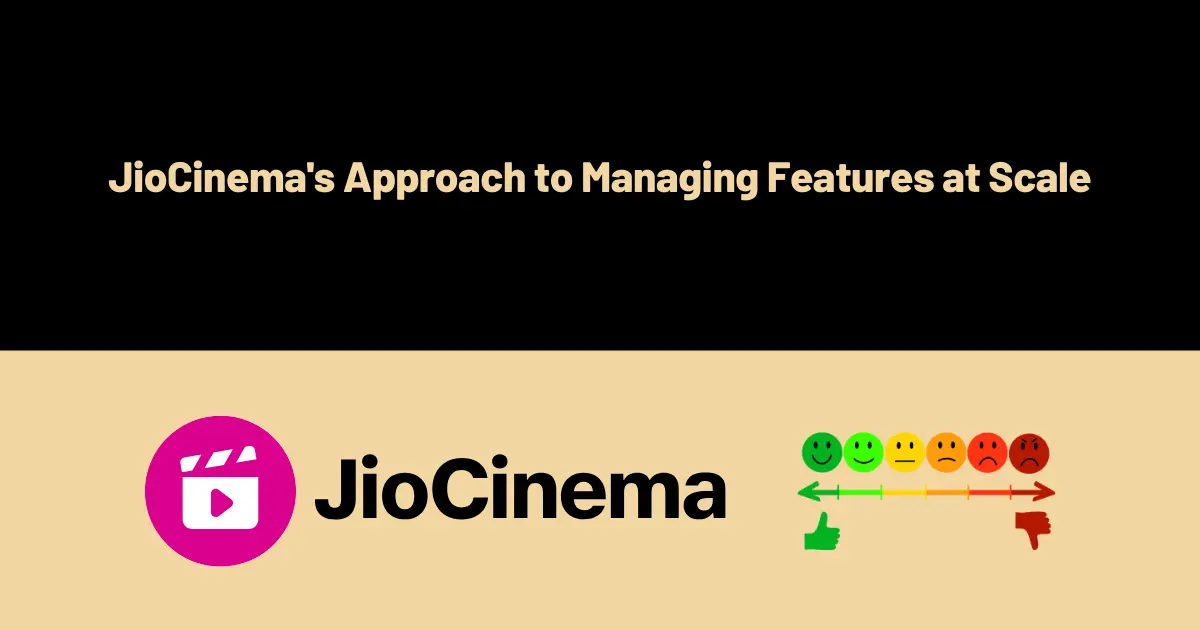In the high-stakes world of live sports streaming, where millions of fans are glued to their screens, the ability to control and adapt your platform in real-time is crucial. JioCinema, India's leading streaming service for the Indian Premier League (IPL), has mastered this art through the strategic use of feature flags. Let's dive into how JioCinema leverages feature flagging to manage its platform at an unprecedented scale, serving up to 20 million concurrent users during IPL matches.
What are Feature Flags?
Before we delve into JioCinema's specific strategies, let's quickly define feature flags:
Feature flags (also known as feature toggles) are a software development technique that allows teams to modify system behavior without changing code. They enable or disable features remotely without deploying new code, providing fine-grained control over functionality.
JioCinema's Feature Flagging Philosophy
For JioCinema, feature flags aren't just a development tool—they're a critical component of their operational strategy during high-traffic events like IPL matches. Here's how they approach feature flagging:
1. Granular Control
JioCinema implements feature flags at various levels, allowing them to:
- Toggle features by platform (iOS, Android, Web)
- Control functionality by user segments or geographies
- Adjust features based on current system load
This granularity enables them to optimize performance where it's needed most.
2. Rapid Response to Issues
With millions of concurrent users, even minor issues can quickly escalate. Feature flags allow JioCinema to:
- Quickly disable problematic features without a full deployment
- A/B test fixes in real-time on a subset of users
- Gradually roll out new features or fixes to manage risk
3. Performance Optimization
During peak loads, every bit of system resources counts. JioCinema uses feature flags to:
- Disable non-critical features to free up resources
- Adjust caching strategies on-the-fly
- Modify API call frequencies based on current system capacity
JioCinema's Feature Flagging Implementation
Let's look at some specific ways JioCinema implements feature flags:
1. Critical Path Protection
JioCinema categorizes its features into three tiers:
- P0: Core streaming functionality
- P1: Important but non-critical features
- P2: Nice-to-have features
During high-load periods, they can quickly disable P2 and even some P1 features to ensure the core streaming experience (P0) remains smooth.
2. Geographic Load Balancing
By implementing feature flags based on geography, JioCinema can:
- Adjust video quality settings for regions experiencing network congestion
- Enable or disable certain features based on regional infrastructure capabilities
- Manage traffic to specific CDNs (Content Delivery Networks) by region
3. Experimentation at Scale
Even during high-traffic events, JioCinema uses feature flags to:
- Test new features on a small percentage of users
- Compare different algorithms (e.g., content recommendation systems)
- Validate performance improvements before full rollout
4. Graceful Degradation
In worst-case scenarios, feature flags enable JioCinema to implement "panic modes":
- Switch to static, pre-generated content for non-critical sections of the app
- Disable real-time features like live chat or social integrations
- Adjust streaming quality to reduce overall system load
The Technical Side of Feature Flagging
JioCinema's feature flagging system isn't just about flipping switches. It's a sophisticated system that includes:
- A centralized configuration service: This allows for real-time updates to feature flag states across their entire infrastructure.
- Integration with monitoring systems: Feature flags are automatically adjusted based on current system metrics and predefined thresholds.
- Audit trails: All changes to feature flags are logged for post-event analysis and troubleshooting.
- Fallback mechanisms: In case the feature flagging system itself experiences issues, there are predetermined default states for all flags.
Challenges and Considerations
While feature flags offer tremendous benefits, they also come with challenges:
- Complexity: Managing a large number of feature flags can become complex. JioCinema has to carefully document and regularly review their flags.
- Testing: With many possible combinations of enabled/disabled features, thorough testing becomes crucial.
- Technical debt: Old or unused feature flags can accumulate, requiring regular cleanup.
- Performance overhead: Checking feature flags adds a small but non-zero overhead to each request, which JioCinema has to optimize for.
Conclusion
JioCinema's sophisticated use of feature flags demonstrates the power of this technique in managing large-scale, high-traffic applications. By providing fine-grained control, enabling rapid response to issues, and allowing for real-time performance optimization, feature flags have become an indispensable tool in JioCinema's arsenal.
As streaming platforms continue to grow and face increasing demands for reliability and performance, the strategies employed by JioCinema offer valuable lessons. Feature flagging, when implemented thoughtfully and systematically, can provide the flexibility and control needed to deliver exceptional user experiences, even under the most demanding conditions.
For developers and platform architects looking to scale their applications, JioCinema's approach to feature flagging offers a blueprint for success. By embracing this technique and adapting it to their specific needs, they too can build systems capable of performing under immense pressure while maintaining the agility to evolve and improve continuously.






